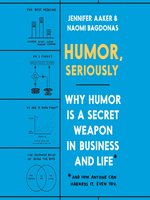من تصميم Jennifer Aaker
Don’t miss the authors’ TED Talk, “Why great leaders take humor seriously,” online now.
“The ultimate guide to using the magical power of funny as a tool for leadership and a force for good.”—Daniel H. Pink, #1 New York Times bestselling author of When and Drive
We are living through a period of unprecedented uncertainty and upheaval in both our personal and professional lives. So it should come as a surprise to exactly no one that trust, human connection, and mental well-being are all on the decline.
This may seem like no laughing matter. Yet, the research shows that humor and laughter are among the most valuable tools we have at our disposal for strengthening bonds and relationships, diffusing stress and tension, boosting resilience, and performing when the stakes are high.
That’s why Jennifer Aaker and Naomi Bagdonas teach the popular course Humor: Serious Business at the Stanford Graduate School of Business, where they help some of the world’s most hard-driving, blazer-wearing business minds infuse more humor and levity into their work and lives.
In Humor, Seriously, they draw on findings by behavioral scientists, world-class comedians, and inspiring business leaders to reveal how humor works and—more important—how you can use more of it, better.
Aaker and Bagdonas unpack the theory and application of humor: what makes something funny, how to mine your life for material, and simple ways to identify and leverage your unique humor style. They show how to use humor to rebuild vital connections; appear more confident, competent, and authentic at work; and foster cultures where levity and creativity can thrive.
President Dwight David Eisenhower once said, “A sense of humor is part of the art of leadership, of getting along with people, of getting things done.” If Dwight David Eisenhower, the second least naturally funny president (after Franklin Pierce), thought humor was necessary to win wars, build highways, and warn against the military-industrial complex, then you might consider learning it too.
Don’t miss the authors’ TED Talk, “Why great leaders take humor seriously,” online now.
“The ultimate guide to using the magical power of funny as a tool for leadership and a force for good.”—Daniel H. Pink, #1 New York Times bestselling author of When and Drive
We are living through a period of unprecedented uncertainty and upheaval in both our personal and professional lives. So it should come as a surprise to exactly no one that trust, human connection, and mental well-being are all on the decline.
This may seem like no laughing matter. Yet, the research shows that humor and laughter are among the most valuable tools we have at our disposal for strengthening bonds and relationships, diffusing stress and tension, boosting resilience, and performing when the stakes are high.
That’s why Jennifer Aaker and Naomi Bagdonas teach the popular course Humor: Serious Business at the Stanford Graduate School of Business, where they help some of the world’s most hard-driving, blazer-wearing business minds infuse more humor and levity into their work and lives.
In Humor, Seriously, they draw on findings by behavioral scientists, world-class comedians, and inspiring business leaders to reveal how humor works and—more important—how you can use more of it, better.
Aaker and Bagdonas unpack the theory and application of humor: what makes something funny, how to mine your life for material, and simple ways to identify and leverage your unique humor style. They show how to use humor to rebuild vital connections; appear more confident, competent, and authentic at work; and foster cultures where levity and creativity can thrive.
President Dwight David Eisenhower once said, “A sense of humor is part of the art of leadership, of getting along with people, of getting things done.” If Dwight David Eisenhower, the second least naturally funny president (after Franklin Pierce), thought humor was necessary to win wars, build highways, and warn against the military-industrial complex, then you might consider learning it too.




